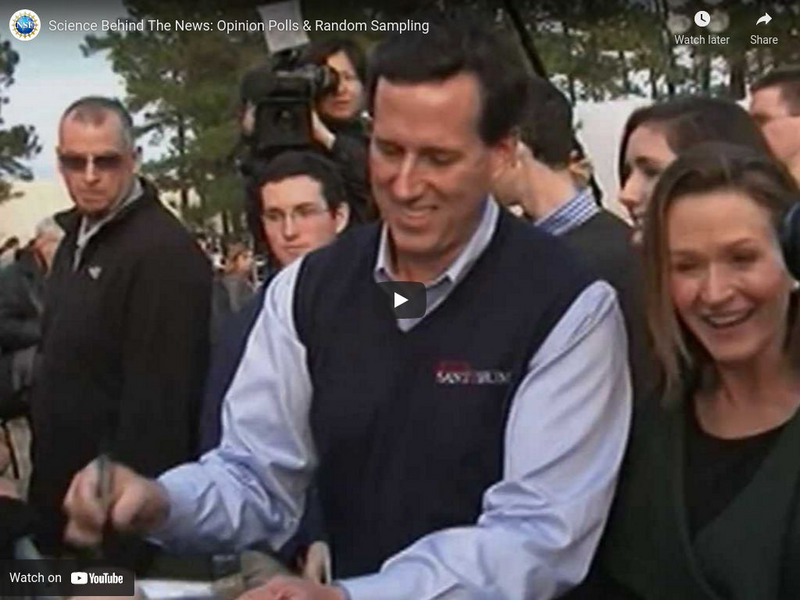National Science Foundation
National Science Foundation: Ocean Temperatures Changing Planet
Dr. Tony Knap, of BIOS in Bermuda explains how climate change is causing ocean temperatures to rise, and what impacts it may bring around the world. [6:05]
National Science Foundation
National Science Foundation: Rising Sea Levels
Scientists predict the rise in sea level will only increase, and they're studying changes in the ocean and land to better understand how and why the water is rising. [6:20]
National Science Foundation
National Science Foundation: Science of Innovation: What Is Innovation?
See how the process of innovation happens. This series of steps begins with imagination, and results in the creation of something of value for society. [6:56]
National Science Foundation
National Science Foundation: Science of Innovation: Anti Counterfeiting Devices
Scientists are researching methods of embedding biomarkers into products to identify them as real as opposed to counterfeit items, using nanotechnology. [5:50]
National Science Foundation
National Science Foundation: Science of Nhl Hockey: Hockey Geometry & Science
This 10-part video series explores the science and math behind professional hockey.
National Science Foundation
National Science Foundation: Science of Nhl Hockey: Force, Impulse & Collisions
The movement of a puck in an NHL hockey game must follow the rules of physics, which involve the concepts of force, impulse and collisions. [5:05]
National Science Foundation
National Science Foundation: Science Behind the News: Opinion Polls & Random Sampling
Explains the science behind the public opinion polls and random sampling that are used during political elections, and how they can be used to predict how the wider population might vote. [4:07]
National Science Foundation
National Science Foundation: Science of Nfl Football: The Pythagorean Theorem
Explains how the Pythagorean Theorem can be used to analyze the movements of football players when a defender tackles a ball carrier. [3:44]
National Science Foundation
National Science Foundation: Science of the Winter Olympics: Downhill Science
Scientists explain the physics of the downhill skiing event at the Winter Olympics. [3:59]
National Science Foundation
National Science Foundation: Science of the Winter Olympics: Aerial Physics
Freestyle skiers use three basic twisting techniques to perform complex jumps in the air. These aerial maneuvers can be explained in terms of physics concepts. [4:00]
National Science Foundation
National Science Foundation: Science of the Winter Olympics: Snowboarding
Scientists explain the physics of snowboarding by talking about dynamic balance, gravity, force, kinetic energy, and potential energy. [4:08]
National Science Foundation
National Science Foundation: Science of the Winter Olympics: Blade Runners
Explains how Newton's Three Laws of Motion are expressed in the context of speed skating. [4:17]
National Science Foundation
National Science Foundation: Science of the Summer Olympics: The Impact of Jenny Simpson
U.S. runner Jenny Simpson suffered from a stress injury due to her running, and used antigravity treadmill technology to help her recover in time for the 2012 Summer Olympics. [4:17]
National Science Foundation
National Science Foundation: Science of the Winter Olympics: Air Lift
Olympic athletes and scientists discuss the physics involved in scoring well in ski jumping. [4:19]
National Science Foundation
National Science Foundation: Science of the Summer Olympics: Designing a Fast Pool
Scientists explain the engineering that went into the design of the London Aquatics Center for the 2012 Summer Olympics. In order for swimmers to perform their best, the waves are minimized using features that absorb the wave energy. [4:43]
National Science Foundation
National Science Foundation: Science of the Winter Olympic Games: Physics of Slope Style Skiing
A scientist explains the physics of slope-style skiing, e.g., rotational motion, moment of inertia, angle of momentum, and friction. [4:58]
National Science Foundation
National Science Foundation: Science of the Summer Olympics: Missy Franklin and Fluid Dynamics
The principles of fluid dynamics need to be understood by swimmers in order for them to compete at the Olympic level. A scientist explains about drag, thrust, and streamlining using the example of U.S. swimmer Missy Franklin. [4:59]
National Science Foundation
National Science Foundation: Science of the Winter Olympics: Science of Skis
Members of the U.S. Ski Team and scientists explain the materials science that goes into making the skis used by the team. [5:05]
National Science Foundation
National Science Foundation: Science of the Winter Olympics: Banking on Speed
The American bobsled team, scientists, and a bobsled designer explain how they hope to win a gold medal at the Vancouver Winter Olympics in 2010. [5:05]
National Science Foundation
National Science Foundation: Science of the Winter Olympics: Internal Athlete
Cross-country skiers are among the fittest athletes, and must press the limits of their endurance in order to win at the Olympics. Scientists discuss the biochemistry behind their endurance levels. [5:06]
National Science Foundation
National Science Foundation: Science of Winter Olympic Games: Olympic Movement & Robotic Design
Scientists are using control systems engineering to design robots that can duplicate the movements of an Olympic athlete. These robots learn to perfect movements through repetition, just as athletes do. [5:07]
National Science Foundation
National Science Foundation: Science of the Winter Olympics: Competition Suits
Winter Olympic athletes and scientists discuss the science and technology behind the clothing the athletes wear in competition. [5:12]
National Science Foundation
National Science Foundation: Science of the Winter Olympic Games: Injury and Recovery
Biomedical engineer Cato Laurencin describes his pioneering work in tissue regeneration. His research looks at helping high performance athletes such as alpine ski racer Lindsey Vonn to recover faster from ligament damage in a knee...
National Science Foundation
National Science Foundation: Science of the Winter Olympics: Mathletes
Mathematician Edward Burger explains the pervasive role math plays in the Winter Olympics, no matter what the sport. [5:15]






